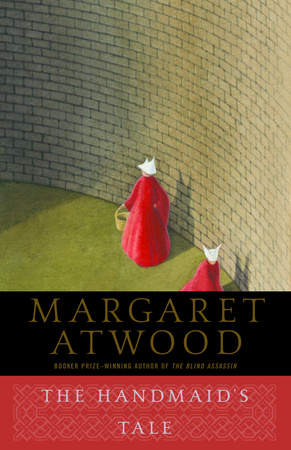
“The Handmaid’s Tale,” by Margaret Atwood, depicts the totalitarian, theocratic society of near-future New England. Now made into a popular American web television series, this dystopian novel follows the life of a handmaid, Offred, who attempts to gain independence from the patriarchy. Handmaids, who are female servants on the bottom of the patriarchal society, are deprived of civil rights, and attempt to gain independence, as seen in Offred’s journey. In an era of declining fertility rates, Handmaids are forced into reproductive servitude.
Perceptive, intelligent, and highly observant, Offred leaves the home of the Commander once a day to shop for groceries. On her walks to the grocery store with another handmaid, Ofglen, Offred learns about an underground organization, “Mayday,” which strives to overthrow the Republic of Gilead. The Republic of Gilead enforces the subjugation of women such as advocating for women’s illiteracy a and forbidding women to own property or have jobs.
Furthermore, Handmaids must also endure the “Ceremony,” a ritualized sexual intercourse between high-ranking men, their Wives and Handmaids to conceive children. The normalcy of the “Ceremony” and how Offred subjugates herself to this oppressive regime struck me as an interesting contrast to the world we live in today, where women’s rights have become one of the biggest global issues.
Offred later develops a relationship with Commander behind Serena Joy, the Commander’s wife who advocates traditional values, and commits illegal acts such as playing Scrabble or reading Vogue. Offred also slips into flashbacks of her old life, which effectively contrasts with the her society full of sexist religious extremists.
If you are a fan of distorted dystopian worlds such as “Nineteen Eighty-Four,” or books that question a women’s role in society, “The Handmaid’s Tale,” is the perfect read.
REVIEW | "A Handmaid's Tale"
October 5, 2018
0
More to Discover


![[PHOTO COURTESY OF PENGUIN RANDOM HOUSE, PENGUIN BOOKS, PENGUIN BOOKSHOP]](https://blueandgoldonline.org/wp-content/uploads/2025/05/books-1200x675.png)
![[PHOTO COURTESY OF ARTE PUBLICO PRESS, SECKER & WARBURG, HOUGHTON MIFFLIN HARCOURT]](https://blueandgoldonline.org/wp-content/uploads/2025/01/Untitled-design.png-1200x609.jpeg)
![[PHOTO COURTESY OF SIMON & SCHUSTER]](https://blueandgoldonline.org/wp-content/uploads/2025/01/IMG_2863-773x1200.jpeg)
![[PHOTO COURTESY OF PENGUIN BOOKS AUSTRALIA]](https://blueandgoldonline.org/wp-content/uploads/2025/01/IMG_2862-767x1200.jpeg)
![[PHOTO COURTESY OF PENGUIN BOOKS LIMITED]](https://blueandgoldonline.org/wp-content/uploads/2025/01/IMG_2864-862x1200.jpeg)
![[COURTESY OF LITTLE, BROWN AND COMPANY]](https://blueandgoldonline.org/wp-content/uploads/2022/09/Circe-Photo-include-photo-credits-courtesy-of-the-publishing-house--558x900.webp)
![A large "Coulda Been Love" sign in front of the show set. [PHOTO COURTESY OF DRUSKI'S COULDA BEEN LOVE SHOW]](https://blueandgoldonline.org/wp-content/uploads/2025/05/IMG_1877-1200x678.jpeg)
![[PHOTO COURTESY OF IMDB]](https://blueandgoldonline.org/wp-content/uploads/2025/05/Untitled-design-2.png)
![[PHOTO COURTESY OF IMDB]](https://blueandgoldonline.org/wp-content/uploads/2025/05/MV5BY2UwOGUxMzEtMzEyZi00NjEwLTkxOTMtYTljOWEzYjYyMWNjXkEyXkFqcGc@._V1_-810x1200.jpg)
![[PHOTO COURTESY OF IMDB]](https://blueandgoldonline.org/wp-content/uploads/2025/03/IMG_3463-1200x724.jpeg)
![[PHOTO COURTESY OF IMDB]](https://blueandgoldonline.org/wp-content/uploads/2025/03/IMG_3465-1200x831.jpeg)
![[PHOTO COURTESY OF IMDB]](https://blueandgoldonline.org/wp-content/uploads/2025/03/IMG_3462-1200x707.jpeg)